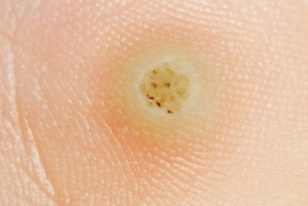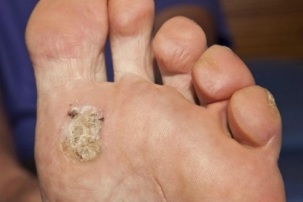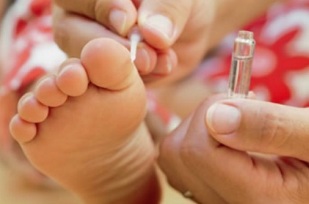
If a rough-top hardening and roughness appears on the soles of the feet, it is either a plant wart or a urn. Differences are important, mainly in the origin and methods of treatment. The inner layer of the skin grows like a sharp thorn, causing severe pain. Doctors recommend removing this skin inflammation if it is damaged and inflamed with shoes.
presence of outbreak on sole of foot
The main part of the common wart on the foot moves inward, into the dermis. The reason is that from the outside the tumor is squeezed by hard surfaces: shoes, various coatings, on which we walk. New growth cells soften the skin. Visible from the tissue. In the picture of a plantar wart, a dense plaque or roller is seen from the outside. The surface of the formation is devoid of skin lines, it contains scales of horny matter. The skin varies: it is denseIs covered with a layer of keratin.
What the plantar wart looks like:
- A nodule or plaque raised above the epidermis by 1–5 mm;
- shape is round, oval, or polygonal;
- The surface is hard and rough to the touch;
- color pink, yellow-white or brown;
- formation diameter 1 to 20 mm;
- missing papillary pattern;
- edges are well defined.
The wart on the foot is characterized by severe pain, which impedes walking until temporary disability. <> / p>

A build-up occurs in areas that are exposed to intense pressure and perspiration. Typical localization of the wart: heel, foot, and toes. At the edge of the nail and under the nail plateThe structures appear painful and difficult to remove. All types of warts have blood vessels inside them that increase living tissue, cells that multiply intensely. Small black dots appear on the surface - blood in the capillaries. Clots; They can bleed when the stratum corneum is cut.
Plantar warts are most common in school-aged children. In about 30% of patients, such structures go away on their own within the first year. However, it is recommended to start treatment when symptoms first appear. Rushes, especially if the plantar wart hurts, or people around have a higher risk of infection. Infection is also dangerous, when individual clusters merge into a mosaic plaque when a group of structures appears in an area. Huh.wart - papilloma virus expression
The skin of the feet is often damaged, constricted and sweaty when wearing tight and uncomfortable shoes. If there are thin-walled blisters with thin liquid inside, these are corns. Sometimes on the surface of keratinA layer is formed, but still, specific skin lines remain.
The appearance of warts on the soles of the feet first goes unnoticed or is considered as a callus. It is necessary to look carefully at the surface of the formation and pay attention to the characteristic signs. It is severe keratinization, absence of skin lines, sore when the surrounding skin is contracted. These are the active reproduction of papilloma virus in living cells of epithelium. The results are.
Planters' warts:
- papilloma virus (HPV) infection;
- weakening the local and general immune defenses; activation of
- virus, entry into epithelial cells;
- Increased multiplication and rapid keratinization of infected cells.
HPV is transmitted through domestic and sexual contact. Contagious agents also penetrate through minor damage to the skin and mucous membranes: cracks, cuts, weeping.< / px >.
Papilloma viruses of the 1st, 2nd, 4th, 27th and 57th types mainly infect cells located in the skin of the foot. The type of plantar development of viral origin is related to simple structures (simple, vulgar). According to the International Classification of Diseases, they are infectious and parasitic diseases. ICD-10 class: "Viral infections are characteristic of skin and mucous membrane lesions. "
Ordinary warts are benign epithelial tumors. They do not initially pose a health hazard. Sometimes such development undergoes malignant changes in a malignant tumor. The process is often triggered by HPV types for which cancerA high risk of development is established.
foot wart treatment
After infection, the incubation period begins: Papilloma virus invades cells, "improving" their reproduction and growth. Much more often, infection becomes latent and in such a dormant state this organismCan remain present throughout its life. In this case the immune suppresses the papilloma virus, putting it into sleep mode without special treatment.
Plantar warts may appear 3–10 years later or several weeks after infection, then disappear in the first year. Within two years.
Not everyone is ready to wait, count on spontaneous healing and cleansing of the skin by developing. Many go to the doctor at the first sign of HPV infection. Skin experts suggest using modern methods of removing warts. , Advises for antiviral therapy, strengthens the skin and the entire body's immune system.
If a sufficient alternative to therapy requires the establishment of the type of HPV, the doctor may prescribe severalAdditional studies determine. Biopsies are performed to collect histological material, an analysis is performed to determine antibodies to papilloma virus.
treatmentOptions:
- Use of special drugs for plantar warts. Dissolution and exfoliation of dead cells.< / lix >
- Laser excision of simple neoplasm with formation of scab, under which therapy occurs. The crust disappears after 7-10 days.
- Cryodestruction with liquid nitrogen. Large warts are removed in many processes. When exposed to low temperatures, a bubble appears, such as after burning.< / lix >
- aElectrocoagulation using electrodes through which a high frequency current is applied to destroy pathological tissues. Painful procedure with a strong odor of burning skin.
- Surgical removal.
- drug injection.
At the beginning of treatment, it is recommended to use a special plaster at home. After softening the wart on the foot with hot water, after cleaning it with keratinized layers using nail scissors and pumice. This inexpensive solution is used. Then a patch is applied. The course of treatment lasts for an average of 3–3 months.
prevention
Papilloma viruses can persist in the environment for a long time. It is essential to keep feet clean, do not go without shoes, especially in public locker rooms, bathrooms, pools. The feet of the soles of other people's skin. It is necessary to use special slippers to protect against contact with contaminated surfaces of particles. Also, do not wear other people's socks and shoes.
Do not scratch the wart, otherwise other parts of the foot will see similar growth.
Papilloma viruses are highly contagious. Disinfect goods for daily hygiene and pharmaceutical applications. Socks and a foot towel should be thoroughly disinfected with warm water, scissors, a nail file, pumice stone. Education, various therapiesBe sure to wash your hands with soap and water after touching the procedures.














































































